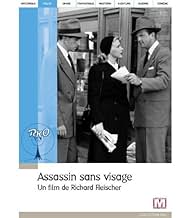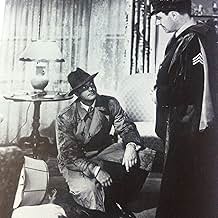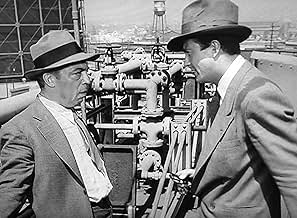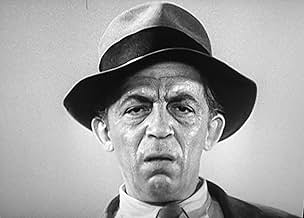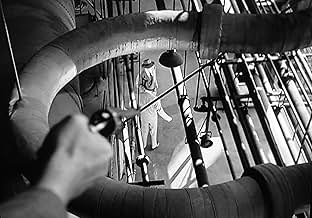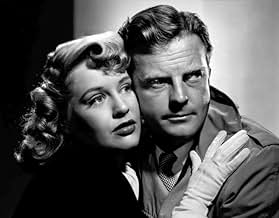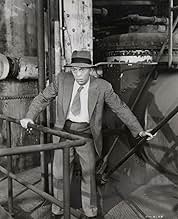IMDb रेटिंग
6.5/10
2.1 हज़ार
आपकी रेटिंग
अपनी भाषा में प्लॉट जोड़ेंAn obsessed cop tracks an elusive serial killer who strangles his victims on rainy nights.An obsessed cop tracks an elusive serial killer who strangles his victims on rainy nights.An obsessed cop tracks an elusive serial killer who strangles his victims on rainy nights.
- निर्देशक
- लेखक
- स्टार
Archie Twitchell
- Dixon
- (as Michael Branden)
Fred Aldrich
- Detective at Briefing
- (बिना क्रेडिट के)
Walden Boyle
- Intern
- (बिना क्रेडिट के)
Paul Bryar
- Sgt. Bryce
- (बिना क्रेडिट के)
Wanda Cantlon
- Waitress
- (बिना क्रेडिट के)
Maurice Cass
- Bookstore Owner
- (बिना क्रेडिट के)
Martin Cichy
- Cop
- (बिना क्रेडिट के)
Art Dupuis
- Detective
- (बिना क्रेडिट के)
फ़ीचर्ड समीक्षाएं
I've been on a film noir fix lately & finding these flicks on You Tube such as Private Hell 36, Crime Of Passion, The Killer Is Loose, Please Murder Me, Raw Deal, Black Angel etc. Most of these I enjoyed & I've watched them once but when I stumbled onto this one yesterday I watched it again today as it was a little more than what I expected. Follow Me Quietly is not really a film noir it's a crime drama & police procedural.
It's a bit experimental & unusual which makes it stand out from the others, the late 40's post war period was a time when filmmakers were trying out new gimmicks such as subjective first person camera like Lady In The Lake (1946) & Dark Passage (1947). The police create a dummy of the killer from what evidence & clues they have which is a little more than the usual routine bulletin description of a suspect.
Sometimes a person can be identified & recognized by the back of their head & ears & the size & shape of their body & physique. Since the police have never seen the killers face the dummy is faceless & startling. The scene where the killer replaces the dummy & sits in William Lundigan's office facing the window with it's back to him is clever but pointless & foolish. What if the detective was smart enough to notice it was really him ? Why would the killer take such a risk ? I think it was just a gimmick & for cinematic effect to satisfy the filmmakers & to give the audience a thrill. The silly trick worked & fooled me I thought it was the faceless dummy.
And when the killers face is revealed he's not what you expect, he's very insecure & nervous & seems incapable of doing anything right. How did he manage to kill 8 victims & get away with it ? The ending is similar to White Heat & this film isn't great but it's fun & interesting, different & memorable & worth watching. I've seen it twice & I may watch it again.
It's a bit experimental & unusual which makes it stand out from the others, the late 40's post war period was a time when filmmakers were trying out new gimmicks such as subjective first person camera like Lady In The Lake (1946) & Dark Passage (1947). The police create a dummy of the killer from what evidence & clues they have which is a little more than the usual routine bulletin description of a suspect.
Sometimes a person can be identified & recognized by the back of their head & ears & the size & shape of their body & physique. Since the police have never seen the killers face the dummy is faceless & startling. The scene where the killer replaces the dummy & sits in William Lundigan's office facing the window with it's back to him is clever but pointless & foolish. What if the detective was smart enough to notice it was really him ? Why would the killer take such a risk ? I think it was just a gimmick & for cinematic effect to satisfy the filmmakers & to give the audience a thrill. The silly trick worked & fooled me I thought it was the faceless dummy.
And when the killers face is revealed he's not what you expect, he's very insecure & nervous & seems incapable of doing anything right. How did he manage to kill 8 victims & get away with it ? The ending is similar to White Heat & this film isn't great but it's fun & interesting, different & memorable & worth watching. I've seen it twice & I may watch it again.
Superb, little-known noir - from a story by Anthony Mann (reportedly, he even directed some of it)! - which is certainly Fleischer's best from the genre after THE NARROW MARGIN (1952). Although it took me a while to warm up to the two leads (especially William Lundigan, given his crucial role of an obsessive police detective who is virtually a mirror-image of the vicious killer, a concept done to death in subsequent thrillers), their relationship is nicely developed and the rest of the cast - particularly Jeff Corey as the hero's wise-cracking sidekick and Edwin Max as "The Judge", when finally unmasked (actually a meek little man, not unlike the Peter Lorre of M [1931]!) - also performs admirably.
However, where the film - a brisk, taut 60 minutes! - truly scores is in its brilliant direction of the suspense sequences: the startling revelatory zoom of the villain's blank-faced dummy is particularly striking, whereas the scene in which we realize that "The Judge" has effectively replaced the dummy in Lundigan's office is genuinely creepy; these two sequences, not to mention the 'look' of the dummy itself, uncannily predate the Italian giallo genre by about 15 years - and I just have to wonder whether Mario Bava had actually watched this film somewhere down the line, and was perhaps reminded of it, when making his own seminal thriller BLOOD AND BLACK LACE (1964)!! Besides, the climax by the huge water tanks is quite splendid, and rarely has the rain been so ominously used as in this film!
A classic of its kind and, in hindsight, an influential one which, hopefully, Warners will consider releasing on DVD soon - as it's actually better than some of the noirs which are out already or have been announced by them...
However, where the film - a brisk, taut 60 minutes! - truly scores is in its brilliant direction of the suspense sequences: the startling revelatory zoom of the villain's blank-faced dummy is particularly striking, whereas the scene in which we realize that "The Judge" has effectively replaced the dummy in Lundigan's office is genuinely creepy; these two sequences, not to mention the 'look' of the dummy itself, uncannily predate the Italian giallo genre by about 15 years - and I just have to wonder whether Mario Bava had actually watched this film somewhere down the line, and was perhaps reminded of it, when making his own seminal thriller BLOOD AND BLACK LACE (1964)!! Besides, the climax by the huge water tanks is quite splendid, and rarely has the rain been so ominously used as in this film!
A classic of its kind and, in hindsight, an influential one which, hopefully, Warners will consider releasing on DVD soon - as it's actually better than some of the noirs which are out already or have been announced by them...
It's been a long time since I last saw Richard Fleischer's "Follow Me Quietly" on TV with commercial breaks making it seem longer than its 60 minute running time.
Looking at it again last week via a Warner Archive DVD that sure looks a lot better than the copy I saw years ago, my first reaction was one of "style over substance" but that's hardly a knock, and actually common for me when it comes to noir. This is really a programmer showing the talent of a director with aspirations, or as Fleischer claimed "This is the film that, above all, increased my knowledge of the trade. I learned how to organize a film." One can see that he was handed a script that is fairly routine, despite Anthony Mann sharing the credit for story. But Fleischer manages to add a few touches here and there to make an impression. The bit in policeman William Lundigan's apartment with the female reporter trying to get some story leads is quite suggestive although the two don't even so much as get into a clinch.
Lundigan, along with partner Jeff Corey, are on the trail of a serial killer known only as "The Judge" and in piling up what few clues they have, they manage to create a dummy that is the killer's size and appropriately dressed based on thread samples found - it's just missing a face. One eerie segment has Lundigan talking to the dummy until Corey walks in and warns him that he's bordering on being as crazy as the killer. But the scene doesn't end there however you'll have to watch it without my spoilers. I will say that here Fleischer does demonstrate his awareness that a film can be more than the sum of its parts.
However that point is teased several times in the film - that Lundigan and the killer may be of the same ilk. Lundigan is so unhinged perhaps to even allow a suspect who is confessing to demonstrate the method of strangulation that he used on a victim. Douglas Spencer makes good use of his minimal screen time in this segment. Even a waitress comments on a pattern of behavior that the cop shares with the criminal.
As Howard Hawks has said, a good film should have three good scenes and no boring scenes. In that respect, Fleischer doesn't let us down, even if a few scenes are the clichéd montage bits of cops pursuing leads, interviewing and pounding the pavement. You have to move the action forward somehow, even in a film that runs only an hour.
There's a mix of location shots (especially good in the finale) and studio sets to represent what we can presume to be Los Angeles. I'm just about certain that "The Judge" lived on the same block that Peter Lorre terrorized in "Stranger on the Third Floor." Dorothy Patrick plays the plucky reporter, she's quite appealing and manages to stay out of the way when told and thus avoiding the need for the cop to rescue the clueless female. In fact she's quite helpful when Lundigan gets a new lead and it's he who struck me as clueless on this point. Jeff Corey shines as Lundigan's partner and walks away with the film with ease.
Looking at it again last week via a Warner Archive DVD that sure looks a lot better than the copy I saw years ago, my first reaction was one of "style over substance" but that's hardly a knock, and actually common for me when it comes to noir. This is really a programmer showing the talent of a director with aspirations, or as Fleischer claimed "This is the film that, above all, increased my knowledge of the trade. I learned how to organize a film." One can see that he was handed a script that is fairly routine, despite Anthony Mann sharing the credit for story. But Fleischer manages to add a few touches here and there to make an impression. The bit in policeman William Lundigan's apartment with the female reporter trying to get some story leads is quite suggestive although the two don't even so much as get into a clinch.
Lundigan, along with partner Jeff Corey, are on the trail of a serial killer known only as "The Judge" and in piling up what few clues they have, they manage to create a dummy that is the killer's size and appropriately dressed based on thread samples found - it's just missing a face. One eerie segment has Lundigan talking to the dummy until Corey walks in and warns him that he's bordering on being as crazy as the killer. But the scene doesn't end there however you'll have to watch it without my spoilers. I will say that here Fleischer does demonstrate his awareness that a film can be more than the sum of its parts.
However that point is teased several times in the film - that Lundigan and the killer may be of the same ilk. Lundigan is so unhinged perhaps to even allow a suspect who is confessing to demonstrate the method of strangulation that he used on a victim. Douglas Spencer makes good use of his minimal screen time in this segment. Even a waitress comments on a pattern of behavior that the cop shares with the criminal.
As Howard Hawks has said, a good film should have three good scenes and no boring scenes. In that respect, Fleischer doesn't let us down, even if a few scenes are the clichéd montage bits of cops pursuing leads, interviewing and pounding the pavement. You have to move the action forward somehow, even in a film that runs only an hour.
There's a mix of location shots (especially good in the finale) and studio sets to represent what we can presume to be Los Angeles. I'm just about certain that "The Judge" lived on the same block that Peter Lorre terrorized in "Stranger on the Third Floor." Dorothy Patrick plays the plucky reporter, she's quite appealing and manages to stay out of the way when told and thus avoiding the need for the cop to rescue the clueless female. In fact she's quite helpful when Lundigan gets a new lead and it's he who struck me as clueless on this point. Jeff Corey shines as Lundigan's partner and walks away with the film with ease.
Follow Me Quietly (1949)
*** (out of 4)
Exciting film noir from RKO has a detective (William Lundigan) trying to track down a mysterious killer known as "The Judge". I haven't heard too many film noir lovers mention this film but I found it to be very tense and brilliantly directed. The film only runs 59-minutes but there's a lot of style throughout each one of them. The ending is full of action and some nice suspense. The film runs at a very fast pace and is over before you know it but for the life of me I can't figure out why this film isn't talked about more. Certainly worth checking out if you can catch it on TCM.
*** (out of 4)
Exciting film noir from RKO has a detective (William Lundigan) trying to track down a mysterious killer known as "The Judge". I haven't heard too many film noir lovers mention this film but I found it to be very tense and brilliantly directed. The film only runs 59-minutes but there's a lot of style throughout each one of them. The ending is full of action and some nice suspense. The film runs at a very fast pace and is over before you know it but for the life of me I can't figure out why this film isn't talked about more. Certainly worth checking out if you can catch it on TCM.
"Follow Me Quietly" is an atmospheric noir about a police detective on the hunt for a serial strangler.
The film's most memorable plot device is a dummy that the police department has made based on the limited information they've been able to capture about the killer. They know roughly his height, weight, hair color, the color of his suit, etc., and they construct a mannequin that approximates his appearance. They then wrangle up crooks and bring them into police lineups with the dummy to see if any of them look alike. It's actually pretty humorous and doesn't seem like the makings of crack detective work, but it does allow for some rather creepy scenes, and one in particular, when the police detective has an entire conversation with what he thinks is the mannequin, and which the audience finds out is the actual killer after the detective has left the room.
If you're a fan of rain-soaked streets and movies whose titles have nothing to do with what they're actually about, you'll like this one.
Grade: B+
The film's most memorable plot device is a dummy that the police department has made based on the limited information they've been able to capture about the killer. They know roughly his height, weight, hair color, the color of his suit, etc., and they construct a mannequin that approximates his appearance. They then wrangle up crooks and bring them into police lineups with the dummy to see if any of them look alike. It's actually pretty humorous and doesn't seem like the makings of crack detective work, but it does allow for some rather creepy scenes, and one in particular, when the police detective has an entire conversation with what he thinks is the mannequin, and which the audience finds out is the actual killer after the detective has left the room.
If you're a fan of rain-soaked streets and movies whose titles have nothing to do with what they're actually about, you'll like this one.
Grade: B+
क्या आपको पता है
- ट्रिवियाFilmed in only sixteen days.
- गूफ़When Detective Grant is in the office trying to solve the serial killings; he begins talking to the "Judge" dummy that is sitting on a chair with its back turned to him. After Collins interrupts him and they both leave the office; the dummy comes to life. It turns out that the real killer hid the dummy and took its place sitting on the chair. The puzzling thing is that the film does not explain how the killer manages to enter the Police precinct and the Detective's office without being detected. In addition, why would the killer want to go there and how did the killer in the first place even know the existence of a lookalike dummy. Finally, Detective Grant has been practically living with this dummy so it makes no sense that he couldn't tell even from the back that it was a real human being there. All these factors briefly interrupted the flow of the story.
- भाव
Lt. Harry Grant: Funny thing how he always strikes in the rain.
Sgt. Art Collins: Maybe he likes rain. Must be a fish.
- कनेक्शनFeatured in Armored Car Robbery (1950)
टॉप पसंद
रेटिंग देने के लिए साइन-इन करें और वैयक्तिकृत सुझावों के लिए वॉचलिस्ट करें
विवरण
- चलने की अवधि1 घंटा
- रंग
- पक्ष अनुपात
- 1.37 : 1
इस पेज में योगदान दें
किसी बदलाव का सुझाव दें या अनुपलब्ध कॉन्टेंट जोड़ें



